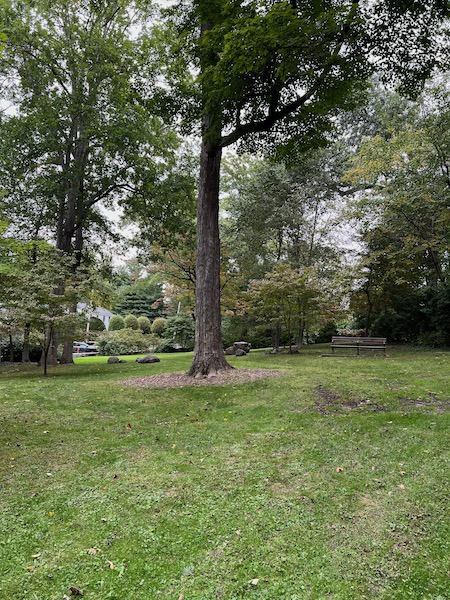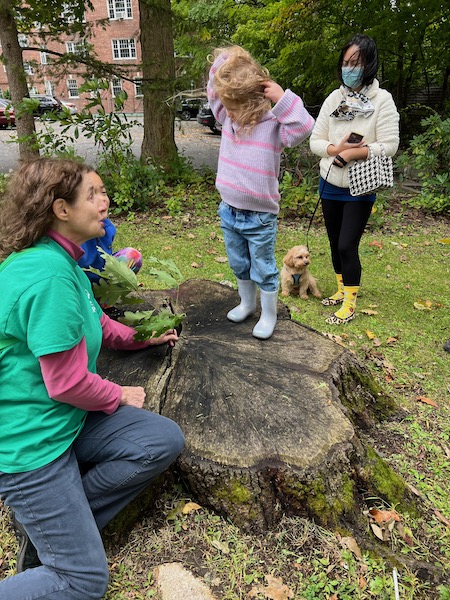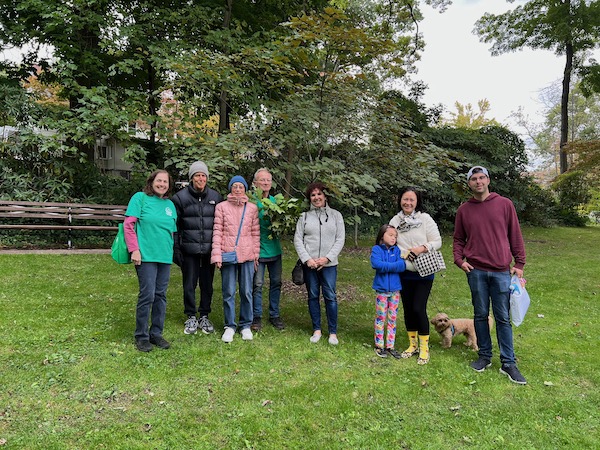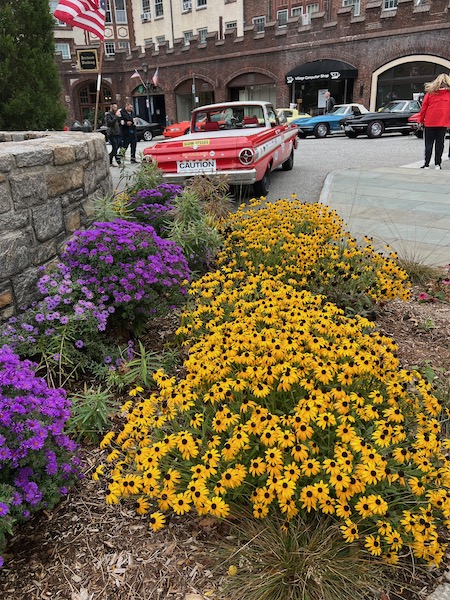Exploring Scarsdale's Tree Canopy
- Tuesday, 04 October 2022 17:42
- Last Updated: Wednesday, 25 September 2024 14:23
- Published: Tuesday, 04 October 2022 17:42
- Joanne Wallenstein
- Hits: 2943
 There’s a reason Scarsdale wins the Tree City award every year and why we’re called a Village in a Park. That’s because the Village treasures, manages and cares for our tree canopy. That was evident on Sunday October 2, when Cynthia Roberts, a board member of the Friends of Scarsdale Parks, offered two “tree” tours of Chase Park in Scarsdale Village.
There’s a reason Scarsdale wins the Tree City award every year and why we’re called a Village in a Park. That’s because the Village treasures, manages and cares for our tree canopy. That was evident on Sunday October 2, when Cynthia Roberts, a board member of the Friends of Scarsdale Parks, offered two “tree” tours of Chase Park in Scarsdale Village.
Despite threatening weather, residents came out to learn about our trees and ask questions about their own. Roberts was knowledgeable about tree identification, tree care and a wonderful proponent for preserving green space in the Village.
After discussing the towering oaks and tulip trees, she showed off the native dogwoods and evergreens and explained the environmental interplay between trees, moss, birds and insects.
Here are a few questions that were posed on the tour – and answers from Cynthia.
What benefits do trees bring to the environment?
Our gorgeous trees explain why Scarsdale is known as “a Village in a Park.” Trees produce the oxygen we breath, eliminate pollutants from the air, slow and absorb rainwater preventing floods, and regulate the temperature. Trees also raise property values, save heating and cooling energy, and improve human mental and physical health. While they are producing oxygen, trees take in and store climate-changing carbon dioxide. Planting trees is one thing we can do today to help slow climate change. Roberts explains how to determine that age of a tree.
Roberts explains how to determine that age of a tree.
Trees play an essential role in our local ecosystem by harnessing the sun’s energy and creating food by a process called photosynthesis. Remember that only plants can produce food. And leaves are the basis for all food chains. For example, the white oak tree (Quercus alba in botanical nomenclature) co-evolved in this region with the other plants, insects and animals, and is therefore considered a “native” tree here. The White oak is reported to support more native insects than any other species of tree in the Northeast. Why is supporting these insects important? We wouldn’t have many songbirds without thousands of soft caterpillars that comprise the “baby-food” that Mom and Dad songbird need to feed a nest of chicks in spring. Chase Park’s collection of towering white oaks furnishes rich wildlife habitat not only via their leaves that feed insects, but also by providing nesting sites and producing acorns, which feed myriad mammals and birds.
Why do leaves turn colors in the fall?
The colors we see in leaves come from pigments, natural materials produced by leaves. When we see green leaves, this is due to the green pigment chlorophyll. This is the most important pigment because it enables the tree to use sunlight, water and carbon dioxide (via photosynthesis) to produce oxygen and food for the tree in the form of carbohydrates. Carotenoids are another type of pigment, which can be yellow, orange, or brown. You may be familiar with them because they are found in carrots. In the fall when the days get shorter and the temperature cools, leaves stop producing chlorophyll, and the yellows, oranges and browns of the carotenoids are unmasked. They were there all along but were hidden by the chlorophyll. Some tree species produce an additional set of pigments in the fall, called anthocyanins. These allow us to see pink, red, and purple leaves. The amount of this type of pigment varies with the weather each year. We will see the most pinks, reds and purples during falls following wet springs, and when fall weather gives us sunny days and cold, but not freezing nights.
Why do people put mulch around their trees’ trunks?
The primary reason to put mulch (shredded bark, wood chips, or leaves) under your trees is to promote healthy tree growth. Mulching helps by:
1. keeping the mowers and weed-wackers away from your tree’s trunk,
2. retaining moisture in the soil during the summer,
3. reducing weed growth under your tree, and
4. improving the quality of the soil as the mulch decomposes.
How much mulch should I put around my tree?
Please do not allow anyone to pile mulch up against your tree’s trunk. A practice known as “volcano mulching”, this promotes bark decay and can promote unhealthy root growth. The best practice is to keep mulch 2 inches away from the trunk. In addition, the recommended depth of mulch under trees is 2-3 inches. For a small young tree, the mulch layer can be spread on the ground starting from 2 inches away from the trunk and extending out to the tree’s drip line. The drip line is the outer circle where rain would drip off the leaves of your tree onto the ground. On a large tree, however, mulching out to the drip line would encompass an enormous area. Some homeowners might not want to mulch the entire area because much of your yard would be covered in brown mulch. In that case, simply apply mulch starting 2 inches from the trunk and extending out as far as you like, but at minimum several feet from the trunk to keep the mowers away and to provide the other benefits of mulch.
Another solution is to connect your mulched trees by creating planting beds around them. I have replaced most of my front lawn with planting beds that encompass trees, shrubs and native perennial flowers. This keeps the mowers away from my trees and allows me to mulch the entire bed while maintaining an attractive front yard.

What are some of your favorite native trees, which might be a good choice for a Scarsdale yard?
Below are a few of my favorite small to medium-sized trees that are native to this region. The first three sport spectacular spring blooms and produce fruit that feeds wildlife.
1. American dogwood (Cornus florida):
Large white flowers, red berries, and crimson fall color
2. Eastern redbud (Cercis canadensis):
Heart-shaped leaves, pink-purple blooms and gold fall color
3. Serviceberry (Amelanchier arborea):
Multi-stemmed often, a cloud of early spring white blooms followed by dark blue fruits and orange fall color.
4. American holly (Ilex opaca):
This is an evergreen that produces shiny green spine-tipped leaves and red berries. These trees provide year-round privacy screening. Note that only the female American holly produces berries, so consult your nursery before purchasing.
When is the best time to prune your trees?
The timing of pruning depends on your purpose in pruning. Experts say that pruning to remove dead wood or a few small branches can be done in any season, but suggest avoiding fall pruning due to the seasonally enhanced presence of fungal spores. Otherwise, it is best to research your species of tree for the optimal pruning time or ask a professional arborist. Most private arborists will inspect the condition of your tree without charge. Be sure that the arborist is certified by the International Society of Arboriculture or another recognized program and is insured.
Westchester County provides a comprehensive website to empower Westchester residents to grow more plants. There is an extensive section on Trees, which includes guidance on how to select a tree species for your yard, pick out a tree at a nursery, and plant, mulch, and prune the tree. This website was created thanks to over 100 Westchester residents who volunteered their expertise and time.
If you have questions about your trees, email us at scarsdalecomments@gmail.com.
 A perennial garden installed by the Friends of Scarsdale Parks at Boniface Circle.
A perennial garden installed by the Friends of Scarsdale Parks at Boniface Circle.










